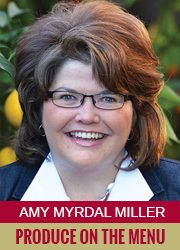 I recently engaged in a heated argument with a well-known campus dining leader. We were talking about plant-forward trends on college campuses and his Gen-Z customers’ willingness to try new protein-rich foods.
I recently engaged in a heated argument with a well-known campus dining leader. We were talking about plant-forward trends on college campuses and his Gen-Z customers’ willingness to try new protein-rich foods.
“We need more protein substitutes made from plants,” he said. I disagreed, pointing out how much protein people can get from plant sources like beans without forming them into a nugget or patty. “You’re wrong!” he insisted. He went on to explain his theory that to “wean” (his words, not mine) people off meat, the market needs more substitutes that look and taste like meat, but are made from legumes, vegetables, grains, etc. “These products are like nicotine patches for the animal protein addicted.”
I personally think “mock-meats” (my words, not his) are disgusting. And comparing them to nicotine patches does little to change my attitude. As an omnivore, if I want to eat a chicken nugget, I’ll eat a chicken nugget. And if I want to eat soybeans, I’ll eat edamame or tofu. But I’m a dinosaur, a member of the Gen-X generation. My consumer wants and desires don’t matter to most marketers. Today, it’s all about the Gen-Z customer.
But here’s the funny thing about Gen-Z diners. My campus dining colleagues all agree these students are adventurous, open-minded, and they demand authenticity. What is so authentic about a bean and barley hotdog, I wonder?
Isn’t there an endless number of ideas for using protein-rich plant foods inspired by world cuisines? India alone could provide a dish a day for the next century. The same could be said for Calabria, the region of Italy best known for being so tight with animal protein, they don’t use eggs in their pasta.
Then jackfruit walked onto the scene. Campus dining operations are using it in place of meat in a variety of ways as companies like The Jackfruit Company, Boulder, CO, are selling meat-free entrees in stores like Whole Foods.
A June 2016 article on Epicurious.com compared unripe jackfruit to “vegan pulled pork,” but my fellow Gen-X and Baby Boomer colleagues say the comparison isn’t accurate. The allure for the Gen-Z diners is the story. You start talking about other cultures that have been using jackfruit in both sweet and savory forms for hundreds, if not thousands, of years and they lean in. Then you mention sustainable production and their eyes get wide as their heads start nodding.
Protein has been a leading positive marketing attribute for many years, but most consumers have no clue where protein comes from and how various sources compare.
There is great potential for selling more produce in a country hungry for protein in all forms. Protein has been a leading positive marketing attribute for many years, but most consumers have no clue where protein comes from and how various sources compare. Sure, they’ll buy buffalo jerky as a protein-rich snack, and they’ve embraced Greek yogurt for its protein content. But ask a consumer how much protein you get in a cup of cooked broccoli, and they’ll likely have no clue that the broccoli’s protein content matches that of a large egg. Jackfruit only contains 3 grams per cup, yet it’s being hailed a miracle protein food. These are the claims that make a dietitian like me completely nuts. But as a culinarian, I can appreciate the allure of an unripe fruit whose texture and appearance mimics that of meat. There are many factors that go into producing delicious, nutritious, foods that are appealing to a wide range of people.
Going back to my headline question, should the produce industry care about protein? In a recent Technomic “protein in foodservice” study, nearly 60 percent of consumers reported they are interested in ordering more vegan and vegetarian entrees with new or unique flavors in restaurants. The percentage was higher for consumers, ages 18-34. This same study looked at why consumers are seeking more meat-free, poultry-free and seafood-free meals. The top response? “I’m trying to eat healthier.” Great! Let’s figure out how to put more produce on their plates.
Another interesting finding from this study was that consumers believe eating multiple proteins in a single meal is much healthier than eating a single protein. Combining proteins is not new in foodservice, but there are major opportunities to take classic menu items like bacon cheeseburgers and make them more healthful.
So, what is the big opportunity for the produce industry? Start by telling a good story. Talk about sustainable farming practices. Talk about flavor. Talk about protein content. And then talk about ways to combine your protein-packed produce item with other protein-rich foods. I’m a big believer that eggs are the gateway to greater vegetable consumption at breakfast. Just think about the opportunities for talking about their cage-free eggs and your free-range vegetables.
Amy Myrdal Miller, MS, RDN, FAND is a farmer’s daughter from North
Dakota, award-winning dietitian, culinary nutrition expert, and founder and president of Farmer’s Daughter Consulting, Inc. Learn more about her business at www.farmersdaughterconsulting.com. Follow her insights on food and flavor issues on Twitter @AmyMyrdalMiller.


